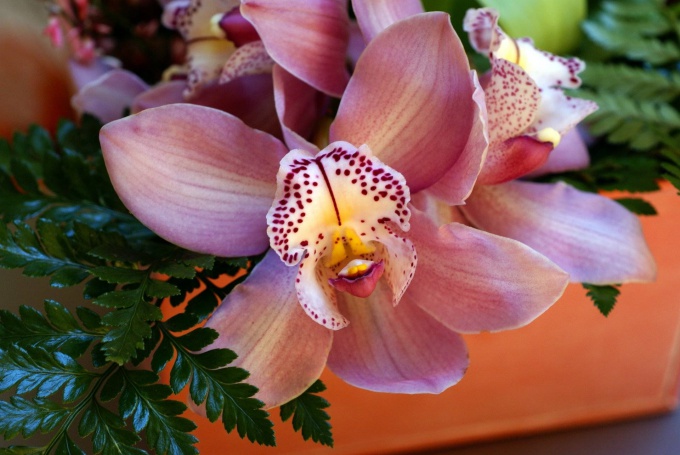When you need to transplant an Orchid
Many doubt the need to transplant the plant: sometimes doing it in a timely manner, and sometimes in a hurry with this procedure. As a result, the plant dies or ceases to blossom. To avoid this, you need to clearly define the conditions in which transplanting orchids is simply necessary, namely:
- the substrate disintegrated prematurely;
- in a pot appeared pests (snails, millipedes, ticks, worms, etc.);
- the plant is filled with water (due to rotting roots);
- a plant hanging in a pot;
- the root system of the flower is placed in the pot;
- a year has passed since the purchase of orchids;
- previous transplanting the plants were 2 years ago.
The ideal time to transplant orchids
The spring months are the most favorable time for transplanting orchids. During this period, the spring sun can smooth out all the stress that the plant would have received from the change of place of residence. From October to February should not disturb a flower without a critical need.
In addition, it is necessary to consider a plant if the flower is to monopodial subspecies, to transplant orchids need only with the emergence of green tip formed at the roots. Sympodial orchids are transplanted immediately after the appearance of new shoots, but not necessarily before they start to grow roots.
The preparatory phase
Transplant orchids begins with the drying: roots are still damaged, however, dry wounds quickly heal, even if they got the bacteria. In that case, if the flower is difficult to shake out of the pot, it can moisten. Before planting the Orchid should dry out. It must be put to dry on a towel for 8 hours. In new flower pot, do not water for about a week. You should also avoid direct sunlight on the plant.
Before you repot the Orchid, you need to prepare the following materials:
- secateurs a small size;
- scissors;
- a plastic pot with holes around the perimeter of the bottom;
- new bark;
- coal;
- alcohol (70%).
In order to avoid transmission of bacteria, viruses and fungus the shears and scissors should be treated with alcohol. Also this should be done before the circumcision, the sick parts of the Orchid.
Transplant plants
At the first stage of the flower need to get out of the pot. In order for this process to go less painful for a flower pot you need to hold both hands up until the plant roots begin to separate from the sides.
Then you need to see the roots of the Orchid from the substrate. It can be easy to shake. In some cases you will have to divide the roots to remove the substrate. Thus, we need to move from the bottom up. Those roots that are grown into the substrate, not to be touched. It is useful to wash the roots of the orchids in water at room temperature.
Transplanting orchids is a process that requires attention and patience from the grower. So, all the roots and substrate of which benefited the plant should be thoroughly inspected for pests.
If pests were detected, all the roots of the flower should be soaked in water for a few hours. This will lead to the death of most of them. Pests need to identify and then treat the Orchid with an appropriate cleaner.
You then need to trim all the rotten and dead roots. The latter is easy to determine if you squeeze them with your fingers: they will be empty or they will leak fluid.
Other roots is not recommended to touch, even if some of them are broken. It may have a negative impact on the condition of the whole plant.
Replant the Orchid in the pot a little more, but this is optional. Dendrobium prefer close to the pots at the same time, orchids sympodial species are best to plant in the clear container large. You first need to fill the pot drainage to⅓. This is great for concrete, granite stones or foam. To capacity was more stable, and the flower was convenient to water, often on the bottom of the pot put a few granite stones. First they need to check: put a few drops of vinegar.
The plant sits in a pot and cover with portions of the new substrate. Periodically the capacity to tap on the table. After planting Orchid should not wobble in the pot. Large pieces of bark should be placed at the bottom of the pot, smaller at the top.
If you repot the Orchid in an old pot, it must be pre-treated with 70% alcohol. Five days after transplantation of the plant should not be watered. You can only spray the leaves.
Care after transplant
Some time after the transplant orchids need to observe her: a healthy plant will quickly recover from a “change of residence” and begin to grow at an accelerated pace.
Unhealthy plants, which at the time of transplant had been pruning the roots require special attention. They need to maintain a certain level of humidity. Phalaenopsis are placed together with the pot in a plastic bag, and then have it periodically ventilated.
Tips on caring for orchids
Transplanting orchids is stressful for plants. Some of them may not even recover from it. Proper care will make the flower more strong and will prevent rotting of the root system. Accordingly, this will avoid problems with flowering orchids.
- You need to maintain a certain temperature. The optimum temperature is in the range of 15-28 ° C;
- high level of humidity. Every day flower needs to be sprayed;
- good lighting. This will depend on the development and flowering of orchids.
Transplanting orchids is necessary, and in some cases a necessary process, which will depend on, will the plant continue to live or not.



